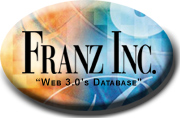Allegro Common Lisp (ACL) Initialization
This document supports the AllegroGraph Lisp Client Quick Start guide with additional information about initializing Allegro Common Lisp before running the AllegroGraph Lisp Client.
We presume that you have installed Allegro Common Lisp 8.2 and are about to run it for the first time. ACL will require initialization, which consists of downloading and compiling updates from Franz.com.
- The first time you run Allegro CL you must have full administrator privileges. Open a terminal window and log in as root.
$ su Password: - Navigate to the ACL installation directory.
- Run Allegro Common Lisp. Modern case-sensitive Lisp (mlisp) was used to generate the Quick Start examples.
- In the resulting Lisp listener window, update the Allegro CL software. This will open a network connection to Franz.com, to download patch files.
- When the download is finished, exit Lisp window. This will return you to the command prompt as root.
- Navigate to the Allegro CL installation directory and run the update.sh script. This recompiles Allegro CL with the latest updates.
- Log off as root.
- To run the AllegroGraph Lisp Client, you must start the AllegroGraph server and Allegro CL under the same user account. You cannot run the Lisp Client as root.
- You may return to the AllegroGraph Lisp Client Quick Start guide and proceed by starting Lisp and the Interactive Development Environment.
# cd /usr/local/acl82.64/ # ./mlisp cl-user(1): (sys:update-allegro) (exit) # cd /usr/local/acl82.64
# ./update.sh # exit If you installed AllegroGraph using the "rpm" method, the configuration script asked you for the name of a user account to store as the "RunAs" parameter of the agraph.cfg file. You will need to run Allegro CL using this same account.
If you installed AllegroGraph using the "tar.gz" method, simply start AllegroGraph server and Allegro CL from the same non-administrator account.
In either case, now is the time to log in as a non-adminstrator.
